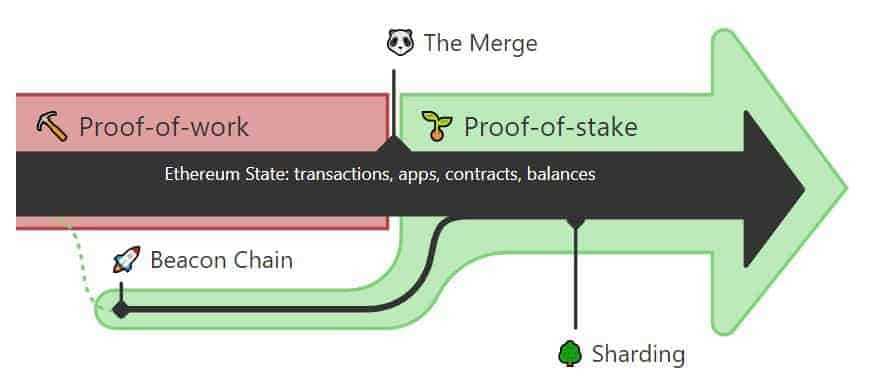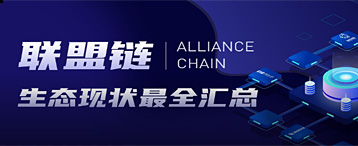-
Ethereum’s History: From Whitepaper to Hardforks and the ETH Merge
 Mandy Williams
Mandy Williams 2022-12-26
2022-12-26 3811
3811 Crypto wiki
Crypto wiki
-
Summary:A closer look at how it all started, the major hard forks, and where Ethereum is headed next.
Ethereum is the second largest digital currency, the birthplace of blockchain smart contracts and decentralized applications (dApps), and holds a key market share in the total amount locked in this field. Before the advent of competitive service platforms in other markets, Ethereum was 90% dominant in the dApp market.
Even so, Ethereum is still the undisputed dominator of dApp. Although the charging standard is very high, the website is still the best choice for different applications, from the financial industry, trading center and storage to mobile games, irreplaceable tokens (NFT) and remediation. This shows how much development it has achieved since the industry report was published in 2013.
This article focuses on the timeline of the big event that makes Ethereum the most popular decentralized blockchain network for dApp developers, as well as the trip to prove its rights and interests.
2013: The concept of Ethereum
Like everything else, Ethereum originated from an idea. Vitalik Buterin, an Australian computer program born in Russia, clearly proposed the idea of using blockchain scientific research to develop decentralized application software, while BTC was strictly established for the main purpose of the financial industry.
Buterin, founder of BTC magazine magazine, released his graduation thesis in the form of Ethereum guide words at the end of 2013. This one
The industry report describes the concepts, basic concepts and possible test cases of new technologies. However, this project will not be operational until 2 years later.
On January 23, 2014, Buterin officially announced the operation of the Ethereum ecosystem and called on young volunteers, developers, investors and preachers to add this project. This program ape shows that he is working with Gavin Wood and Jeffrey Wilcke to build the platform as an important key developer. Other founding team members include Howard Dijorio, Franz Lupin and Clive Hoskinson.
Buterin also mentioned that the purpose of its elite team is to provide a platform for decentralized applications - an Android mobile phone system in the world of digital currency. All efforts can share a set of common APIs, untrustworthy interaction and uncompromising
Three months later, Field released the "Yellow Book" of the project, which brought about the specific definition and improvement of the Ethereum ecosystem, including the Ethereum vm virtual machine (EVM) and the mining fee incentive blockchain smart contract. He numbered the first role of the new project into seven computer languages based on his assistance, demonstrating his leading role in establishing the prototype of Ethereum.
2014 crowdfunding project: supporting Ethereum with BTC worth 18 million US dollars
Ethereum real estate developers must spend a lot of money to build this project. Therefore, the group decided to raise funds from the public investors according to the 42 day Initial Token Offering (ICO) from July 20 to September 2, 2014.
In June 2014, the project established the Ethereum Charity Foundation, a non-profit organization located in Germany and Switzerland, which is responsible for the laws, regulations and marketing of ICO activities. The Charity Foundation has created 60 million Ethereum (ETH), which is also the original digital currency of the Ethereum ecosystem to publicize the market sales. Two weeks before the ICO, the enterprise sold 2000 Ethereum (BTC) per BTC, and 1399 ETH per BTC for the rest of the token marketing campaign.
Interestingly, the charity foundation sold more than 50 million tokens within 14 days before the crowdfunding project. At the time of the event, the project raised 31531 BTC in total, with the use value exceeding 18 million dollars. This also made Ethereum's crowdfunding project the fifth successful ICO in the history of data encryption (at that time).
The non-profit organization also created another 12 million ETH, making the total output of forged medical ether reach 72 million ETH. The company indicated that the additional tokens will be used for marketing and other development and design theme activities.
2015: The emergence of Ethereum
A few months after the crowdfunding project, ETH DEV held the first theme activity of Ethereum, named DEVCON-0, which invited Ethereum developers around the world to discuss the reliability and scalability of the contract.
In April 2015, the Charity Foundation launched the first free fee scheme DEVgrant to apply to the best new projects in the Ethereum ecosystem, which is still in operation until the industry is pre operational.
In May 2015, the Ethereum development team released Olympic, which is a network test version, paying close attention to four industries - buying and selling theme activities, virtual machine use, exploration capability and stability tests implemented by blockchain smart contracts. The Charity Foundation will award 2500 ETH and other honorary awards to test engineers in each type of product testing.
limit
After the product testing of the Summer Olympic Games, Ethereum was officially launched on July 30, 2015, which has been several years since Buterin published the industry report of this project. The first public release of this project, called Frontier, represents an important milestone for the elite team in the face of developers and technical customers. This is also the emergence of a new blockchain ecosystem, which is suitable for all types of decentralized applications. Even after the agreement is completed, it will also produce a series of upgrades.
Like BTC, the newly launched agreement uses the PoW consensus mechanism. Ethereum created the first blockchain (Genesis Block) based on Frontier, which includes 8893 Ethereum transactions with different wallets. The blockchain reward is 5 ETH. During this period, medical ether was of no value because it had not yet been marketed. Investors participating in the ICO still own tokens.
Ice Age in Ethereum
The Ethereum development team launched the Ice Age on September 7, 2015, and launched the difficulty coefficient time bomb on the 200000 blockchain. This is a difficulty coefficient adjustment scheme, which is committed to improving the mining difficulty coefficient in the network after every 100000 regions, so that mining can not keep up with the increasing difficulty level. This will cause the network to freeze over time and become known as the "Ice Age"
The establishment of this function is to ensure that the ecosystem can reach an agreement on future upgrading, and turn Ethereum into a consensus network of PoS.
of one's own unit
On March 14, 2016, in 1150000 commercial streets, the team launched an upgrade called "Homestead" nearly a year after Frontier was launched. The latest version includes GUI, so the website is very beneficial for non-technical customers.
Bifurcation can also improve the service platform through the Ethereum Improvement Program (EIP), which ensures that the service platform can be upgraded in the future.
DAO attack in 2016: 360000 ETH stolen
On April 30, 2016, in blockchain 1428757, Ethereum created a decentralized secret name organization (DAO). The DAO raised funds from more than 11000 investors to use Ethereum worth 150 million dollars, but few people understand that such success is not easy to continue.
A.
The decentralized autonomous organization (DAO) is similar to the shareholders' meeting of enterprises. The difference is that the members of the DAO are anonymous, and their voting rights are determined by the total number of tokens granted.
Less than three months after the announcement of the DAO, the DAO was invaded by hackers. Because its developers started the project without careful approval. The network attack was transferred from the website to about 3.6 million ETH. At that time, the use value was 60 million dollars, which caused the bifurcation of Ethereum network to recover the stolen property.
This event adds the first real threat to the survival and development of Ethereum. Due to the failure of DAO, it will have a devastating adverse impact on the new blockchain network, and at the same time, it will cause economic losses to investors. As DAO has become one of the largest projects in Ethereum.
The Ethereum community tried a soft fork to prevent permanent changes to the blockchain, but this did not work. Then a hard split was implemented, and the assets were repaired and returned to the investors.
The hard fork represents the permanent offset of the latest version of the blockchain to upgrade or separate the old chain. Hard bifurcation is generally implemented by new dynamic passwords or chain members who expect to establish operation according to different standards.
Ethereum has established a new blockchain after the DAO attack. At first, the network was renamed as the Ethereum tradition, and the new chain preserved its name - Ethereum.
It is worth noting that the Ethereum will experience several hard bifurcations in the future. However, unlike the DAO, except for the upgrade of Beacon chain in 2022, none of them caused the collapse of the chain in dispute, which turned Ethereum into a PoS consensus mechanism. Other key upgrades in the network include Orange Whistle, False Dragon, Byzantium and Constantinople.
2020: Ethereum scalability problem
After experiencing the DAO event, the next key test of Ethereum is the scalability problem. Like BTC, Ethereum blockchain is facing a blockchain trilogy, which is also the definition that Buterin first used when describing the main functions of the decentralized blockchain network.
The founder of Ethereum indicated that safety factor, decentralization and maintainability are the three elements of blockchain network. However, it is difficult for blockchain to have all three functions at the same time. In other words, it must compromise one main function to improve the other two functions.
By the end of 2017, Ethereum had become the favorite blockchain smart contract service platform for dApp developers. The network also enjoyed the happiness generated by the original bull market, and the blockchain mobile game CryptoKitties pulled the group into the Ethereum ecosystem. This has resulted in network congestion, and the purchase and sale must take a long time to be determined, and the gas cost will also soar.
The problem of scaling up in Ethereum has created a sales market for products outside the chain such as Polygon.
You can be at the bottomIn depth articles.
The prosperity of DeFi in 2020 and 2021 does not make Ethereum more and more easy. Although blockchain continues to maintain an obvious adoption rate, users are troubled by huge gas charges, so customers should choose cheaper alternatives, such as BNB Chain and Tron.
In order to solve its scalability problem, Ethereum launched an upgrade in December 2020, which means the beginning of the network connection from PoW to PoS. The upgrade can only be performed after 16384 ETHs with 32 tokens are saved in the detailed transaction address.
Stock certification is a blockchain consensus mechanism, which authenticates data encryption trading based on randomly selected verifiers and establishes a new blockchain, while PoW needs to mine and deal with mathematical problems. In PoS, the verifier must bet his money before they allow him to buy or sell in the authentication network.
PoS is a consensus mechanism that proves that the architecture design has a higher safety factor and is more environmentally friendly and energy-saving than the work unit. According to the opinion of the Ethereum Foundation, the company confirmed that it would be better to implement a new solution to scale up, and Ethereum should adopt such a solution more than ever before.
An independent PoS chain, called Beacon chain, has been upgraded and created, which is operated in parallel with the launch of Ethereum PoW main network. Subsequently, the two chains will be combined to form a single network called Ethereum 2.0 or ETH 2.0. However, the Charity Foundation renamed the name "consensus layer", emphasizing that ETH2 sounds like a new computer operating system, but it is not. The reconstruction of well-known brands is part of the charitable foundation's efforts to prevent customers from becoming victims of fraud such as ETH for ETH2.
2022: Ethereum
The Ethereum development team released several types of upgrades after the release of Beacon Chain, laying the foundation for joint efforts. Some of these upgrades are Altair and Bellatrix.
The precise explanation provided by Ethereum Charity Foundation is:
"The joint venture means that the current decision-making level of Ethereum (the main network we are using now is online) and its new equity confirmation consensus layer - portal chain integration."

On September 15, 2022, Ethereum Hepin was completed in the blockchain 15,537,393 according to the upgrade called "Paris, France". During the upgrade, more than 13.4 million ETH coins were pledged in the savings contract. In recent years after the advent of Beacon, Bifurcation bears the change of consensus from Ethereum to PoS.
What happened to the PoW mining of Ethereum due to the business merger? The Ethereum network is forked to create an independent chain (similar to the Ethereum tradition). The blockchain is called ETHW, which allows mining to re certify the blockchain based on dealing with complicated mathematical problems for ETH rewards.
You can inquire about the integration manual of Hopei here.
Future: What is the next step after the joint venture?
With the implementation of the achievements of the joint venture, the next key upgrade of Ethereum is Sharding, which is also a multi link upgrade and is committed to improving the scalability and overall volume of the contract. This is called an on chain amplification solution.
The pan entertainment will work in coordination with the second level induction. At the same time, the entire Ethereum network will be divided into system partitions called fragment autonomy, and the network freight volume will be increased by 1000 times. Apart from scalability, Sharding will also bring other benefits to Ethereum, such as more network participation and decentralization of optimization.
It is estimated that the upgrade will be fully implemented in 2024 or later. This means that before this, Ethereum may once again rely on out of chain expansion solutions, such as Layer 2 and the main chain.
Disclaimer:As an open information publishing platform, shilian only represents the author's personal views and has nothing to do with shilian. If the article, picture, audio or video contains infringement, violation or other inappropriate remarks, please provide relevant materials and send it to: 2785592653@qq.com.
Hint:The information provided on this site does not represent any investment suggestion. Investment is risky, and you must be cautious when entering the market.
ShilianFan group:Provide the latest hot news, airdrop candy, red envelopes and other benefits, WeChat: rtt4322.
















